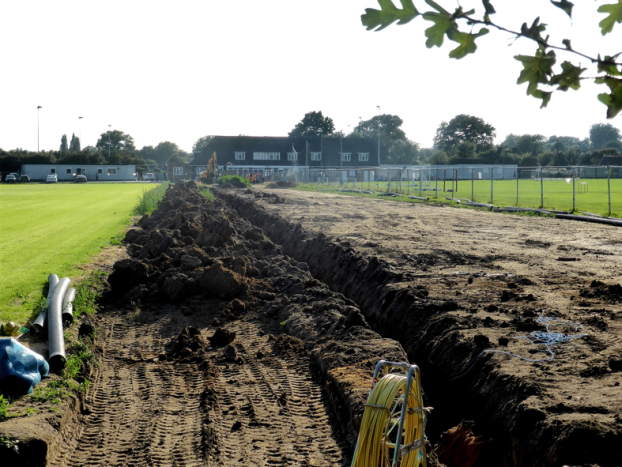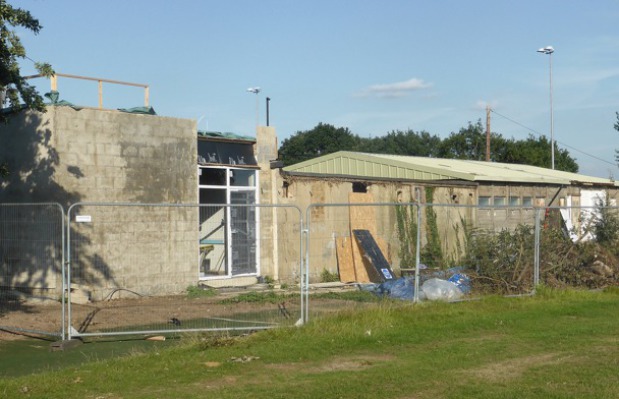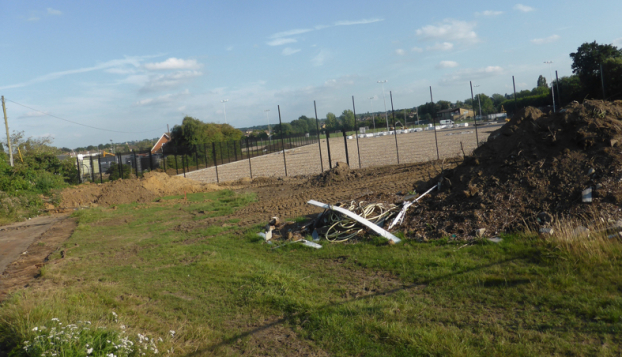The day the earth moved at Sparrows Lane
RICK EVERITT looked behind the scenes at and around Charlton's New Eltham training ground in this article published at the beginning of August in VOTV136…
It has become a running joke among those opposed to Roland Duchâtelet’s ownership of Charlton that when a significant protest looms at The Valley, the club will suddenly start to talk about his investment at the training ground in New Eltham.
Two days before the Coventry City home match last October, the club released a four-minute video on YouTube that offered a rare detailed insight into the work already
completed at Sparrows Lane to provide two new 3G pitches to the north of the site, together with an irrigation pond, as well as plans for the next stage.
By no great coincidence, 48 hours before the final match of last season against Swindon Town, the club released another video. This one was barely a minute long and, somewhat comically, largely
showed piles of earth being moved around.
The message, however, was clear. Work is under way. The owner is investing in the club.
A third, much longer and more detailed video, with commentary by head groundsman Paul Geary, followed in June. Maybe the club was panicking about season-ticket sales?
In fairness, the relaunched official website also contains a useful section breaking down the scheme into four stages and itemising the cost of each.
Scepticism about the video timings apart, this new appetite for explaining the works at the training ground is to be welcomed, especially in the context of the previous
chronic lack of information about the delays, and particularly the absence of a proper overview.
Nevertheless, once you delve a little deeper it is clear that even the latest version of the scheme is years behind schedule, that much of the work being done this summer
has little direct benefit for Charlton Athletic Football Club, and that there is still reason to doubt that stage four – by far the most expensive and significant part – will ever be completed at
all.
The plan to update and improve the club’s facilities at Sparrows Lane began life in 2011, with the Jimenez-Slater board setting the ambitious target for a then League One club of achieving category
one academy status.
This would have the benefits of putting the club’s academy teams into regular league competition with the elite, offer wider scope for recruitment and greater
compensation for young players who leave. But it also comes with hefty additional operating costs.
Blackburn Rovers are set to retain their category one status despite dropping into League One this season, but no club has ever been awarded the top ranking while in the third
tier.
The plan put together by executive vice chairman Peter Varney was based on returning to the Championship, but also heavily focused on the Charlton Athletic Community Trust (CACT), whose existing accommodation at Sparrows Lane was squalid and structurally compromised.
CACT was important, not only in securing the necessary planning consent from the council but also in levering in sufficient funding from a variety of sources to make the works cost-neutral for the
club, which didn’t have money to spend.
After Varney abruptly left the football club – but not, initially, the board of CACT – in mid-2012, the project stuttered along under his replacement Martin Prothero and
chief operating officer Steve Bradshaw, partly because they had lost some of the funding. Eventually, however, it received planning consent in May 2014, five months after Duchâtelet took
over.
The planning statement submitted that February had made clear that the intention was “to replace all of the existing buildings across the site with a new integrated ‘hub’
at the heart, used by all stakeholders, community and club reflecting the totally inclusive ethos of the football club”. The scheme featured eight full-size pitches, one of which had an artificial
surface. It included a new vehicle route from the north of the site to Footscray Road, which was to alleviate the issues caused by the increased traffic that would otherwise use Sparrows
Lane.
Given the timing, Duchâtelet necessarily had little ownership of this proposal, with its intention to “convey the club and trust ethos – warm, dedicated, welcoming,
aspirational and inspirational”, but he was, by all accounts, very interested in it.
He also had the personal wealth to dispense with the compromises that had been necessary to draw in the previous external funding.
With the principle of the development on Metropolitan Open Land having been accepted by the council with the 2014 permission, Duchâtelet very much owned the new
application in the spring of 2015, which starkly asserted: “As is common with a number of clubs, it is best to separate the operation of the community facilities from those of the academy and
professional users. This is what is proposed at Sparrows Lane.”
The 2015 scheme had no access to Footscray Road and isolated the CACT facilities at the front entrance to the site, with a new two-storey building on part of the existing
public car park substantially replacing their inclusion in the main hub.
Much of the previously proposed other community use was also gone, allowing the club to tell planners that there would be no overall increase in traffic and that
therefore the existing Sparrows Lane access was sufficient on its own.
Explaining the need for a new approach, Charlton told the council: “The 2014 application, whilst providing a level of facilities that met most of the category one
requirements, was deficient in relation to lack of a gymnasium as part of the medical facilities (common to all academies); lack of a parent’s [sic] lounge and lack of permanent indoor pitch. Some of
the other parts of the building were also minimal in size, eg medical facilities, classrooms and administrative areas and functionally (upon review) were not ideal... nor future proof.”
As far as the football club facilities are concerned, it is the 2015 scheme – approved that October – which matters. The significant changes from 2014 affecting the club
were the minor relocation of the main building to the south of the previous planned position; the addition of an indoor sports hall to replace the reliance on the Greenwich University dome; living
accommodation for academy players; and that a second of the eight full-size pitches would now be a 3G one.
There’s no question that Duchâtelet’s scheme had a higher specification, including a much-vaunted drainage and rainwater recycling system. It’s a better proposal, if
money is no object. And now there was no planning reason not to get on with it. Indeed, two new 3G pitches and the irrigation pond were soon built, at a stated cost of £1.8m, albeit completion of
phase one lingered through 2016.
But in May that year, Charlton were relegated to League One. In September 2015, the club had reported: “Construction on the new main building is set to begin in April [2016] with a completion date scheduled for the summer of 2017 in time for the start of the 2017/18
season.”
Despite the smoke and mirrors that has surrounded a subsequent planning application for the adjacent Footscray Rugby Sport & Athletics Club (FRSAC) site in February 2016, the club had no planning reason not to proceed with the first team and academy facilities on site after October 2015. However, it very obviously had financial reasons – if money was now an issue. And it was unlikely to be accorded category one status while in the third tier, which removed some of the incentive to proceed.
What did change from the 2015 plan were the CACT facilities. Having first relocated them from the main hub to the front car park, the club now removed the CACT
replacement building too. Now its old single-storey structure – previously regarded as beyond saving – would be partly refurbished and also extended. It would have one classroom, not the two planned
for the new building. Unsurprisingly, the club was reticent about the switch, and I for one missed it at the time.
CACT would also now gain the use of additional land on the council-owned FRSAC site, with the benefit of a new and different access road linking Charlton’s site to
Footscray Road across the rugby club land.
The 2016 planning application was submitted jointly by FRSAC – a registered charity – and Charlton, but it barely touches the land owned by the football club. The only
such area included within its “red line” is the existing CACT building.
Nevertheless, Duchâtelet had turned his approach on its head once again. This time the club told the council that the owner “has clearly stated that his investment into
elite training and community facilities is predicated and contingent on them being inclusive and open to [the] whole community with diverse activities that extend beyond football; used as a base to
deliver activities that meet social and health outcomes aligned to local need; busy and well used as a means of encouraging more people to take part and to enhance and develop CAFC/CACT’s presence in
Royal Greenwich”.
It’s only fair to comment that planning submissions often contain guff like this. It is written for a specific audience – the council – and should not necessarily be
taken at face value.
Now CACT is widely regarded as a good thing and its work is of great value to the football club reputationally, as well as providing benefits to the wider community, including supporting women and girls’ football. Most of us wholeheartedly endorse all of that. But the issue here is one of priorities at the football club.
After all, in their 2015 planning submission (but see caveat above) Charlton had said that the lack of category one status was “severely restricting the club’s ability to attract new players into its academy because of the quality of its facilities. It is also incidentally providing somewhat of a disincentive to attract professional players who regard the academy and training centre as their place of work.”
Manager Karl Robinson even suggested earlier this year that it was the fee from Everton for Ademola Lookman in January which would now allow work at the training ground
to proceed. Yet phase two benefits FRSAC and CACT, not directly the football club itself. Are Charlton really saying that the Lookman money is paying for that? Why, indeed, is the football
club now funding works for CACT at all, when the original Varney plan had been that CACT would help lever in cash for a scheme to benefit the football club?
The new Charlton website says that phase two has a cost of £1.8m. It “sees the club work with neighbouring Footscray Rugby Club, as well as the Charlton Athletic Community Trust, and consists of the construction of a new synthetic community pitch [on the FRSAC site]. It involves the renovation of Footscray Rugby Club’s natural pitches and the construction of two additional 3G pitches for Footscray and CACT” as well as the new access road across the FRSAC site and the CACT building refurbishment and extension.
We can expect this £1.8m “investment” to be in the form of loans from Duchâtelet’s Staprix, rolling up interest into debt at the usual three per cent – or £54,000 in the
first year. The new access road may be useful for the football club, but it is not necessary for its own activities. The consent granted in 2015 puts that beyond debate.
It might be argued that this spending offers better overall value than what would have been the outlay on a new community building, which Duchâtelet’s own 2015 scheme introduced. But that still
doesn’t address the issue of the club’s apparently skewed priorities.
Meanwhile, a recently minted £600,000 phase three, which confusingly is contemperaneous with phase two, does directly impact on the football club. The website says:
“Each of the training pitches have been dug up and relayed with improved drainage… Moreover, 600-metre trenches have been dug and these will enable the training ground to incorporate increased gas
and electricity links, which is essential to the whole redevelopment.”
This work is obviously appropriate and sensible. But it represents a third of the spending on the FRSAC site.
A date for phase four, crucially including the main building approved in October 2015 and now costed at “a minimum of £8m”, is
missing from the website, which is perhaps only prudent. The most recent public statements from the club have suggested completion in late 2018 but chief executive Katrien Meire has stressed that
this cannot be guaranteed.
For once, she and I agree. In the meantime, however, the building used by the first team and the academy remains “severely restricting” and “a
disincentive to attract professional players” – according to the club.
The ambition for a state-of-the-art training ground is a bold and exciting one, and the regime would no doubt argue that the progress this summer shows its commitment to the project. If it eventually gets the job done the owner will take the plaudits. But the question of why the football club should be spending nearly twice its 2017/18 season-ticket revenue on rugby pitches, a road and community facilities, while its first team is stranded in League One, may remain pertinent.





